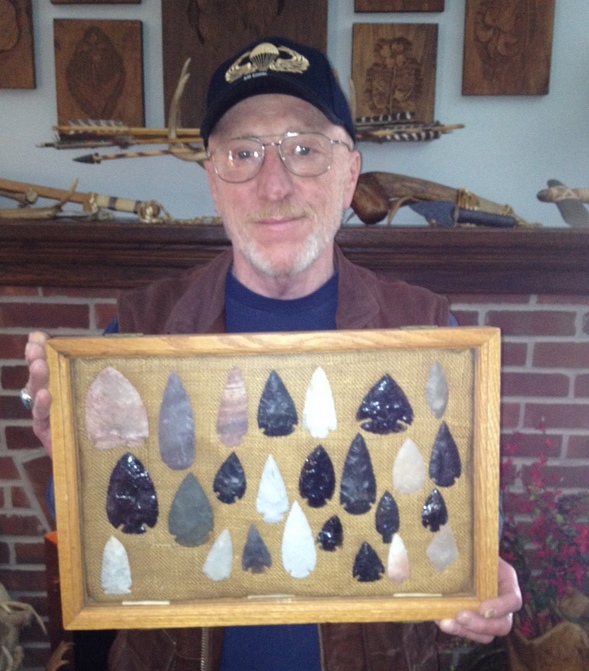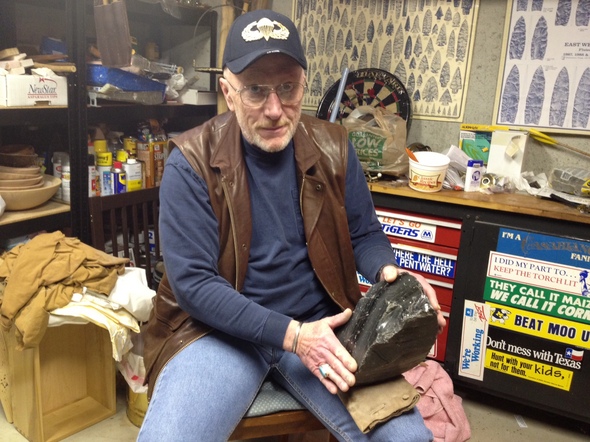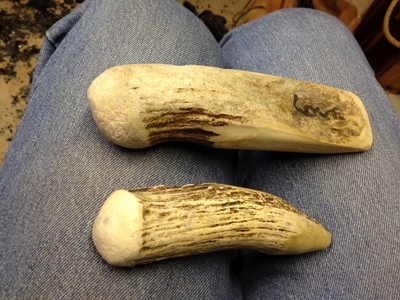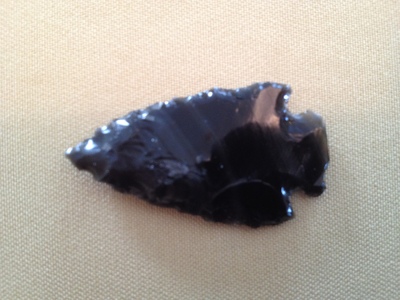Flint knapping - Michigan association keeps ancient art alive

Bob Love, President of the Michigan Flint Knappers Association poses with numerous arrow heads he made.
Rick Taylor | AnnArbor.com Contributor
I've always been fascinated by Native Indian artifacts like stone arrowheads that were used to take down buffalo, deer and other wild animals in order to survive. The big question is how could anyone take a rock and turn it into a lethal cutting tool, especially so when one considers the fact that hardware stores were not around thousands of years ago?
Making arrowheads from rocks was so much more than a hobby; the ability to effectively make arrowheads and other tools was a matter of life and death. Every single one of our ancestors, at one time or another, survived by their ability to hunt and gather. It's truly humbling when you think about it, especially since we're so far removed from it today. Food comes easily to us by a simple trip to the grocery store.
It's my hope to remind all of us how critical, beautiful and effective flint knapping is and how we survived as a species because of it.
Flint knapping is the art of creating primitive arrowheads, axe heads, knives, spears and other tools by carefully shaping rocks into cutting instruments by the use of antler tools, copper and other natural materials.
This story is an important one to me because I found the remnants of arrowheads on a recent Elk hunt to Wyoming. I was also given a beautiful flint knapped knife for Christmas from Guy Sanville, executive director of the Purple Rose Theater.

I knew I wanted to write a story on flint knapping but wasn’t sure whom to contact. Thankfully, a friend of mine recommended I contact Bob Love. Bob is the founder and president of the Michigan Flint Knappers Association. I gave Bob a call, and he graciously invited me to his lovely home for a lesson in flint knapping. Bob lives very close to Ann Arbor. and I showed up to his home the following morning at 10 a.m.
Bob created the Michigan Flint Knappers Association in 1992 and has a loyal membership of fellow flint knappers across our beautiful state.
Bob retired from the Chrysler Proving Grounds three years ago and now spends his time helping the University of Michigan and other learning institutions with his knowledge of flint knapping. Bob has been invaluable to paleontologists, archeologists and anthropologists in their search to better understand our ancestors.
Furthermore, Bob served our country in the Airborne Infantry and was wounded three different times while serving two tours in Vietnam. I’m sure I speak for all our readers when I say "thank you" to Bob for his service to our country.
Bob gave me an amazing tour of his home, and I couldn’t believe all the artifacts he owned. Bob’s house could easily be mistaken for a museum; especially with the quality and quantity of artifacts he possessed.

Elk antlers like these were used by our ancestors to make arrowheads. Bob Love helps keep this tradition alive.
We went to the basement, and it didn't take long for Bob to show me the tools used in flint knapping. Bob took a huge piece of obsidian and illustrated the art of "percussion flaking." Percussion flaking is the first step in flint knapping; it's when you remove a small piece of the rock from a larger rock. The "percussion" is the hammering of the large rock with a piece of elk or deer antler about a foot long.
Once a satisfactory piece of this rock has been cleaved, then you can start "pressure flaking." Pressure flaking is the art of removing unwanted rock in order to create the desired shape of an arrowhead, axe or spearhead.
The removal and shaping of rock is done by pressing against a rock to remove unwanted material, whereas percussion flaking is hammering unwanted material. The length and width of pressure flaking tools of antler or copper would resemble an average-sized screwdriver.
Fine flaking is done by using very narrow tools, while broader tools do the heavy work, so to speak.

Rick Taylor's first flint knapped arrowhead with a little help (a lot really) from Bob Love.
Bob did a magnificent job of explaining the art of flint knapping. Like many things in life; practice makes perfect. Bob talked about flow lines, learning how to read the rock, finding the centerline and a lot of other things I simply can’t remember.
Bob finally gave me a piece of obsidian and, with some help, I made my very first arrowhead.
Bob joked about flint knapping and how you learn to create your own new language when you make mistakes on pieces you’ve worked on for so long.
Bob wanted to thank the Chelsea Rod and Gun Club and Dan Hovater for their continued support of the Michigan Flint Knappers Association. He also wanted to invite the public to stop by the their Michigan Flint Knappers Spring Event on April 1, being held at the Chelsea Rod and Gun Club.
Bring the entire family, as the club will have lunch available for a small fee. You can also watch flint knapping demonstrations and even purchase items while you're there. Finally, bring your bow and arrows on April 1 to the Chelsea Rod and Gun Club for their archery shoot. It’s a great time for novice and expert archers!
I'd like to thank Bob Love for taking the time to enlighten me on the fine art of flint knapping.
For more information on Flint Knapping you can go to their website at www.onagocag.com/michiganknappers.html.
Your comments and story ideas are always warmly welcomed. You can reach Rick at rtaylor@reinhartrealtors.com or by phone at 734-223-5656.

